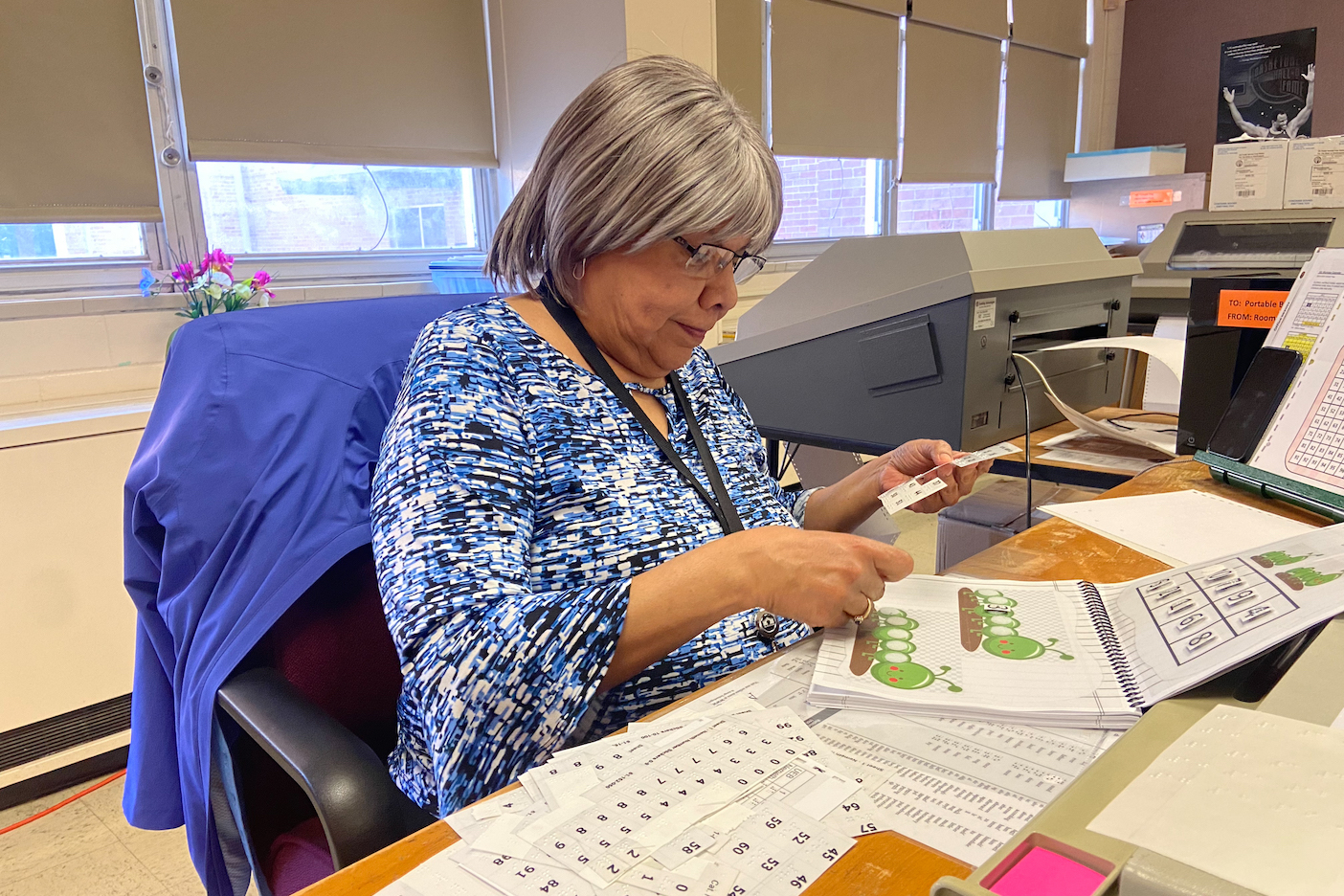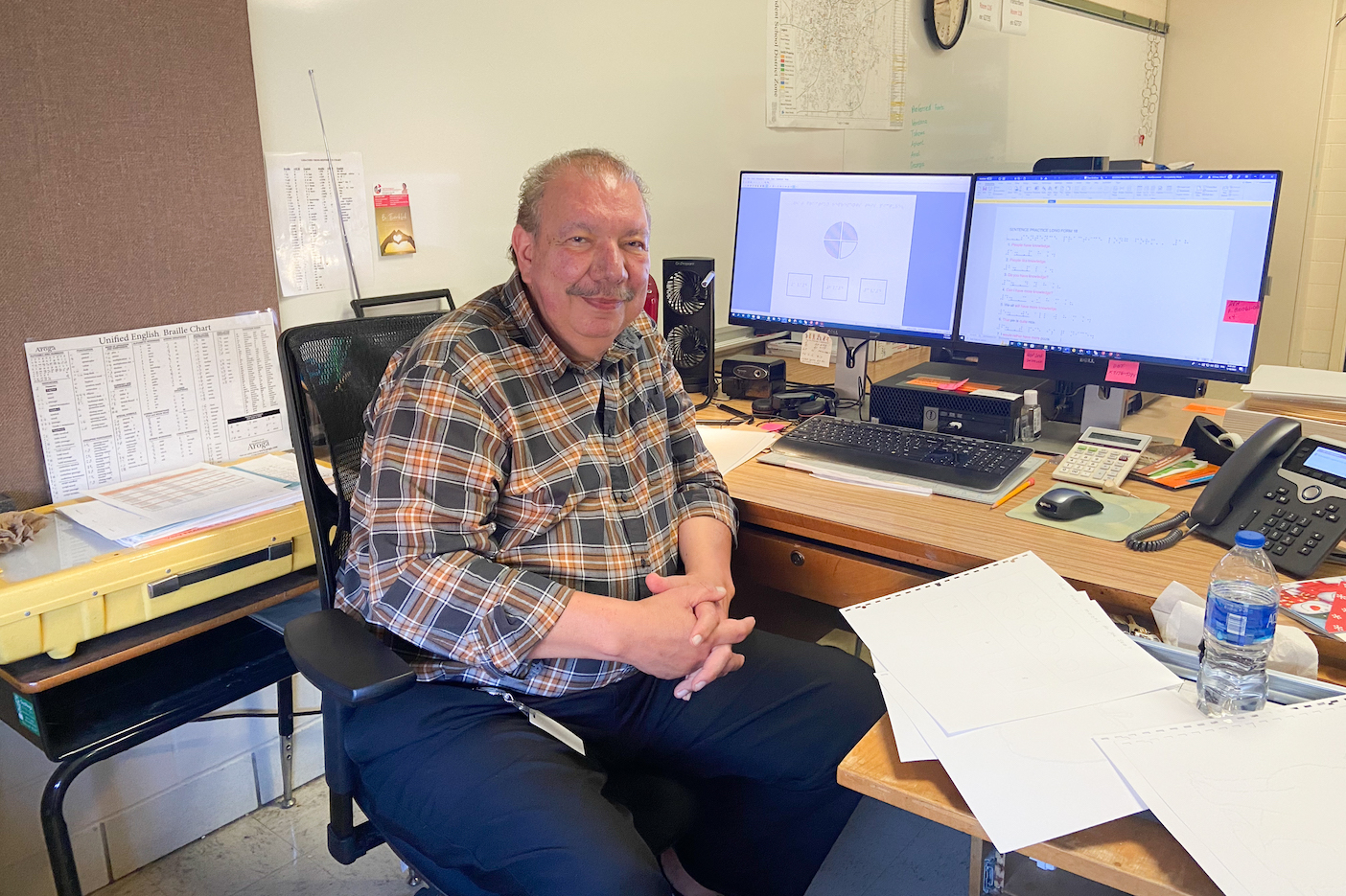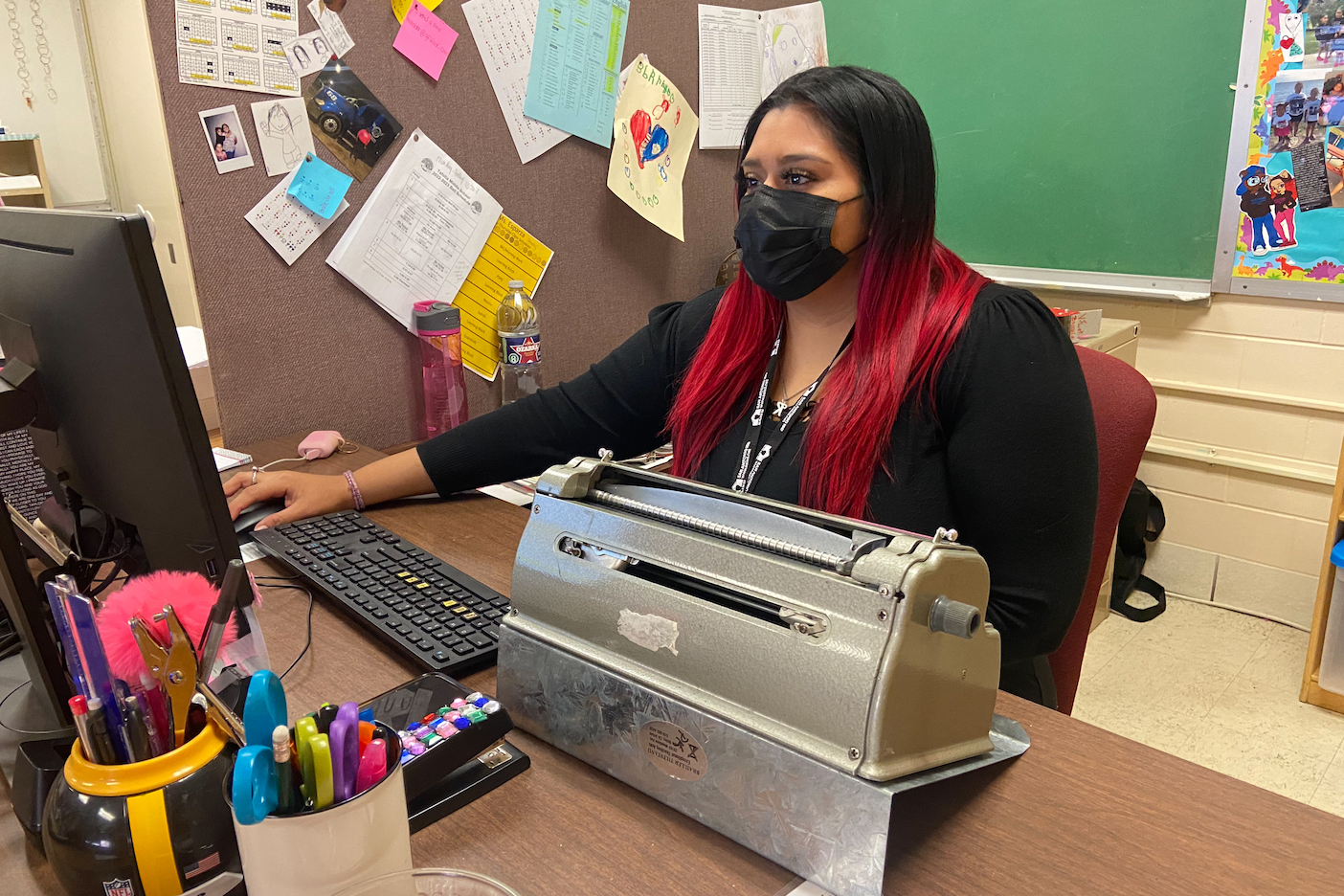 Unassumingly officed on the first floor of Gates Elementary School, a trio of instructional assistants is helping make miracles happen for San Antonio ISD students.
Unassumingly officed on the first floor of Gates Elementary School, a trio of instructional assistants is helping make miracles happen for San Antonio ISD students.
The district’s three braille transcribers — Bonnie Martinez, Michael Ochoa, and Kathleen Taylor — together bring more than 55 years of experience removing barriers to literacy for the district’s students who are visually impaired. As we close out January — Braille Literacy Month — we took some time to get to know them and the tools they use to create accessible materials for students.
Martinez has been transcribing for SAISD for 26 years and plans her retirement soon. When she began with the district in the late 1990s, she passed a typing test and earned her literary braille transcribing certification. She then began transcribing educational materials for students. Her favorite project: the books.
“I enjoy preparing the students’ books into braille code so that our students with visual impairments will have the same copy of what a sighted student is reading — library books, novels, chapter books and textbooks.”
The team uses Unified English Braille (UEB), a code officially adopted by the United States in 2016. The code comes in two forms: Grade 1 uncontracted, which means transcribing letter for letter into braille, or Grade 2 contracted, which saves space by using a system of abbreviations, or contractions, for common words and groups of letters. Uncontracted can be very long – two and a half pages of braille for every single page in print.
The team uses Duxbury software for the transcription, which can switch in and out of Grade 1 and 2 to create personalized materials as students individually learn more contracted code.
 They print to embossers, a technology that has largely stayed the same over the years for literary braille. But Ochoa, who creates many of the math materials and specialized graphics, has seen a change in the way graphic materials are produced.
They print to embossers, a technology that has largely stayed the same over the years for literary braille. But Ochoa, who creates many of the math materials and specialized graphics, has seen a change in the way graphic materials are produced.
“The tactile graphics have changed," Ochoa said. “Now the machines do a lot of the work. We used to do a lot by hand. The machines now are able to reproduce it a lot quicker.”
Ochoa, who received his training from the Library of Congress, has been working with braille for 28 years, the last 13 of which have been for SAISD. He spent a decade at ESC Region 20 before working for another district and ultimately having his own transcribing business. Ochoa uses the Tiger software and printer to create more graphic-based projects such as mathematical models and illustrations.
As qualified instructional assistants, the transcribers go into the classroom to provide additional support for the district’s five certified teachers for the visually impaired (CTVI) who serve nearly 70 students across the district.
“They have the opportunity to work with elementary and middle school students who are visually impaired to improve their ability to read braille and facilitate use of specialized materials during regular class time,” Casie Bland, director of Visual Impairment Services, said.
The team agrees the best part is seeing their work utilized, and watching the students develop their skills in braille over time.
“It’s not an easy thing to learn,” Ochoa said. “It’s so rewarding to see as the years go by and they get older the progress that they make; it’s incredible.”
 Taylor, relatively new to the team with only two and a half years' experience in the department, uses her background as a co-teacher and a library assistant to connect with students and help them with their assignments.
Taylor, relatively new to the team with only two and a half years' experience in the department, uses her background as a co-teacher and a library assistant to connect with students and help them with their assignments.
“I love working with kids,” Taylor said. “That was my passion, so coming in being able to work with kids — and these kids are extra special — it’s really amazing.”
Their time spent in classrooms only helps as they work with the CTVI and general education teachers to brainstorm solutions – tactile versions of classroom materials copied onto swell form paper, individualized materials embossed on the Perkins Brailler, matching activities or classroom displays.
“They go above and beyond when they support our students who are visually impaired in the classroom to ensure they are successful,” Bland said. “They even create bulletin boards and other items to display on campuses to make learning braille more inclusive.”
Since San Antonio ISD is one of only three districts in the area to have in-house braille transcription, Bland said the team’s role is vital.
“Without our team, we would have to send off for transcription or order special materials,” she said. “Having them with us really removes the barrier to literacy and accessing the environment safely.”
The ultimate cheerleaders, the transcribers are a unique group who work on the front lines and behind the scenes helping students.
“To me they are little Einsteins because they learn so fast and yet at the beginning, I didn’t even know my ABCs,” Martinez said. “I had to carry my little card. That’s what I find exciting, to see students getting their education, how excited they get.”
Transcriptores de braille facilitan acceso a la alfabetización
Tres asistentes de instrucción ayudan a generar milagros para los estudiantes de San Antonio ISD en una oficina modesta en el primer piso de Gates Elementary School.
Entre los tres transcriptores de braille para el distrito —Bonnie Martinez, Michael Ochoa y Kathleen Taylor— tienen más de 55 años de experiencia en eliminar obstáculos de alfabetización para los estudiantes del distrito con deficiencias visuales. A medida que acaba enero —el Mes de Alfabetización en Braille— nos tomamos el tiempo de conocerlos a ellos y las herramientas que utilizan para crear materiales accesibles para los estudiantes.
Martinez lleva 26 años transcribiendo para SAISD y tiene pensado jubilarse pronto. Cuando comenzó a trabajar con el distrito a finales de los 1990, aprobó un examen de mecanografía y recibió su certificación de transcripción literaria para braille. Entonces ella comenzó a transcribir materiales educativos para los estudiantes. Su proyecto preferido son los libros.
“Me gusta preparar los libros de los estudiantes con el código braille para que los estudiantes con deficiencias visuales tengan la misma copia de lo que los demás estudiantes estén leyendo — libros de la biblioteca, novelas, libros de capítulos y de texto”.
El equipo utiliza el Código Unificado de Braille en Inglés (UEB, por sus siglas en inglés), el código que se adoptó oficialmente en Estados Unidos en 2016. El código tiene dos formas: el grado 1 sin contracciones se genera al transcribir letra por letra al braille. El grado 2 con contracciones ahorra espacio al utilizar un sistema de abreviaciones, o contracciones, para las palabras y los grupos comunes de letras. La transcripción sin contracciones puede ser muy larga, dos páginas y media de braille por cada página impresa.
El equipo utiliza software de Duxbury para la transcripción, la cual puede cambiar de grado 1 a 2 para crear materiales personalizados a medida que los estudiantes aprenden más código con contracciones de forma individual.
Imprimen con estampadoras, una tecnología que ha permanecido relativamente igual a lo largo de los años para el braille literario. Sin embargo, Ochoa, quien crea muchos de los materiales de matemáticas y los gráficos especializados, ha visto un cambio en la forma en la que se producen los materiales gráficos.
“Los gráficos táctiles han cambiado", dijo Ochoa. “Ahora las máquinas hacen gran parte del trabajo. Solíamos hacer mucho mano. Las máquinas ahora lo pueden reproducir mucho más rápido”.
Ochoa, quien recibió su capacitación por parte de la Biblioteca del Congreso, lleva 28 años trabajando con braille, los últimos 13 con SAISD. Pasó diez años con la Región 20 de ESC antes de trabajar para otro distrito y luego estableció su propio negocio de transcripción. Ochoa utiliza el software y la impresora de Tiger para crear proyectos más gráficos como modelos de matemáticas e ilustraciones.
Como asistentes de instrucción calificados, los transcriptores proporcionan apoyo adicional en el salón de cinco maestros(as) certificados(as) para enseñar a los estudiantes con deficiencias visuales (CTVI, por sus siglas en inglés) que prestan servicio a casi 70 estudiantes en todo el distrito.
“Tienen la oportunidad de trabajar con estudiantes de primaria y secundaria que tienen deficiencias visuales para mejorar su capacidad de leer braille y facilitar el uso de materiales especializados durante el tiempo regular de clase”, dijo Casie Bland, directora de los Servicios de Discapacidades Visuales.
El equipo indica que la mejor parte es ver que se utilice su trabajo y ver a los estudiantes desarrollar sus habilidades de braille con el paso del tiempo.
“No es algo fácil de entender”, dijo Ochoa. “Es tan gratificante ver su progreso con el paso de los años y a medida que crecen; es increíble”.
Taylor, quien es relativamente nueva al equipo con dos años y medio de experiencia en el departamento, utiliza su formación como maestra y bibliotecaria auxiliar para conectar con los estudiantes y ayudarles con sus tareas.
“Me encanta trabajar con los niños”, dijo Taylor. “Esa es mi pasión, así que poder trabajar con los niños —y estos niños son súper especiales— es realmente increíble”.
El tiempo que pasan en los salones es muy útil ya que trabajan con los CTVI y maestros de educación general para hacer una lluvia de ideas en cuanto a soluciones – versiones táctiles de los materiales del salón que se copian en papel en relieve, materiales individualizados estampados en la máquina Perkins de Braille, actividades de concordancia o exhibiciones en el salón.
“Se esfuerzan mucho cuando apoyan a nuestros estudiantes con deficiencias visuales en el salón para asegurarse de que logren el éxito”, dijo Bland. “Incluso crean tableros de anuncios y otros artículos para mostrar en las escuelas a fin de que el aprendizaje de braille sea más inclusivo”.
Ya que San Antonio ISD es uno de solo tres distritos en el área que tiene transcripción interna de braille, Bland dijo que la función del equipo es fundamental.
“Sin nuestro equipo, tendríamos que enviar la transcripción fuera o mandar a pedir materiales especiales”, dijo ella. “El contar con ellos realmente elimina el obstáculo a la alfabetización y el poder tener acceso al entorno de forma segura”.
Los transcriptores son un grupo único que trabaja en las primeras líneas y entre bastidores para ayudar a los estudiantes.
“Para mí son pequeños genios porque aprenden tan rápido y yo en un principio ni siquiera me sabía el abecedario”, dijo Martinez. “Tenía que cargar con mi tarjetita. Eso es emocionante para mí, el poder ver a los estudiantes recibir su educación y lo entusiasmados que se ponen”.